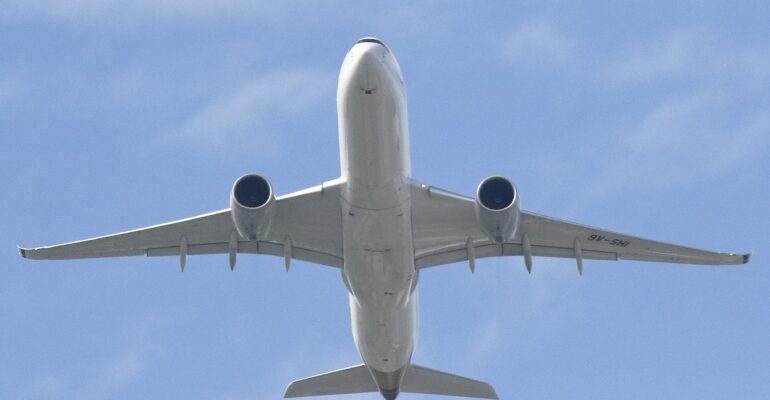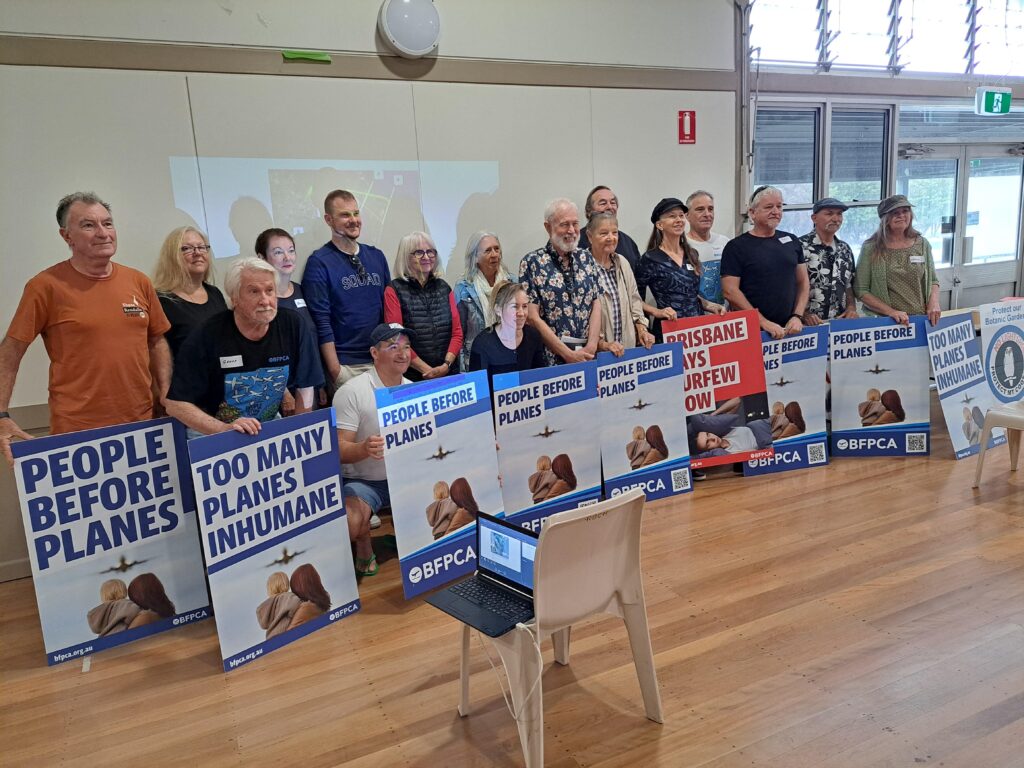
The Brisbane Flight Path Community Alliance (BFPCA) has collated a range of scientific evidence that chronic exposure to aviation noise is bad for people’s health and well-being. It is more than people just being annoyed by aircraft noise, it increases the risk of cardiovascular diseases (CVD), diabetes and a range of other ailments, it also disrupts children’s cognitive development and learning. In brief in ‘advanced’ countries, it is now regarded as a major public health issue – one hidden in plain sight.
BFPCA have just completed a preliminary analysis of the extent and severity of aircraft noise in Brisbane – the great majority being flown for Qantas and Virgin – in and out of Brisbane airport. Plus a brief review of the relevant scientific literature on the health effects of aircraft noise – regarded as the most disruptive of all modern noise sources. Speaking generally, ‘average’ aircraft noise levels on the ground in Brisbane are in the range 65-75 dBA, even louder closer to the airport. This level of exposure to chronic noise is more than just ‘annoying’ it is dangerous for human health and wellbeing.
Complaints from 226 Brisbane Suburbs
BFPCA used information from AirServices Australia (AsA), the (supposed) regulator and designer of aircraft flight paths, as a starting point, it is reported that they received complaints from 226 Brisbane suburbs since the new runway started operating. Then they used FlightRadar24 to identify the suburbs under one or two of the major flight paths. The suburbs under one major flight path were classed as ‘moderately afflicted’, those under two major flight paths as ‘severely afflicted’, the remainder on AsA’s list as ‘slightly afflicted’. We could have made a fourth class: ‘critically afflicted’ – for suburbs close to the airport and under two major flight paths, these experience many more and louder overflights than even ‘severely afflicted’ suburbs.
The preliminary estimate is that some 74 suburbs are ‘slightly afflicted’, 64 ‘moderately afflicted’ and a further 28 ‘severely afflicted’. In terms of the number of Brisbane residents afflicted by aircraft noise we estimated the total as 1.39 million people, about 54% of Brisbane’s population; some 670,000 moderately afflicted and 242,000 severely afflicted.
In Brussels, a major European aviation hub, a city half Brisbane’s size, a health-economics survey of the annual cost of aircraft noise on residents’ health was completed in early 2023. As it happens the number of ‘highly annoyed’ (read severely afflicted) people in Brussels (220,000) is about the same as in Brisbane. The health cost for Brussels residents was estimated as EUR ~2.49 billion/annum – that’s AUD ~4.16 billion/annum. Recall there are about another ~1.15 million Brisbane residents who are slightly or moderately afflicted whose health costs have not been estimated/included.
For comparison, BAC’s annual report estimated net profit for 2022 (excluding taxes, etc.), but affected by the tail-end of the Covid pandemic, of AUD 306.1 million. Another way of looking at this is that BAC costs Brisbane nearly AUD4 billion/annum due to the ‘hidden’ health impacts of aircraft noise. But, a big but, maybe it is Qantas and Virgin – who fly ~95% of noisy flights – who are causing this massive and continuing economic loss for Brisbane? BAC, Qantas and Virgin like to declare annual profits through shifting the real, but hidden, health costs to Brisbane residents.
Can BAC be trusted?
BAC’s Environmental Impact Statement (EIS), which AsA ticked and flicked, estimated that for Balmoral there would be only 5-32 flights over 70 dBA on an average per day – BAC’s own data records an average of 79 flights per day for June this year over Balmoral. The average aircraft noise from these flights is 80 dBA (arrivals) and 77 dBA (departures) – (median 78 dBA, for both) – excessive noise levels well into the danger zone for human health. Balmoral was and is densely populated, and was here long before the (new) airport was opened in 1988. This is a clear indication of how little BAC (or AsA) cares for the health and well-being of Brisbane residents.–
SMBI (Flight Path) Community Action Group
On Saturday 5th October a meeting was held at the Redland Bay Community Hall for representatives from the BFPCA, the SMBI Community Action group and a small group of residents from the Redland area. Members from the Alliance had travelled as far as Samford to share their ideas and concerns about plane noise due to flight paths that are affecting many suburbs of Brisbane. Also represented at the meeting was the local community organisation Redlands2030, which has published some stories alerting people to the emerging threats arising from aircraft noise.

The spokesperson for BFPCA, Marcus Foth President, addressed the group and stressed the need to join together with others across Brisbane to help alleviate aviation noise issues. A major concern expressed by the Redland residents was the noticeable increase in noise due to flights over their suburbs and also the fact that proposed flight paths would take many more planes over the Southern Moreton Bay Islands which would disturb the existing tranquil lifestyle currently enjoyed on the SMBI Islands.
For further information please go to the website: BFPCA and subscribe to the BFPCA Newsletter. Have a read of latest reporting on Redlands2030 To keep track of local action subscribe to the Redlands2030 Newsletter. and join the community commentary.
Redlands2030 – 28 October 2023
Please note: Offensive or off-topic comments will be deleted. If offended by any published comment please email thereporter@redlands2030.net
2 Comments
Congratulations Redlands2030 for publishing this article and thank you once again for publishing the article “Disturbing the peace – aircraft noise over the Redlands” in February 2023. Of major concern to mainland residents in the Redlands is the proposed departure flight path over Wellington Point, Ormiston, Alexandra Hills and Sheldon areas, now being trialled, and the proposed extension over Redland Bay areas. Departures are crossing the coast over Wellington Point and Ormiston, sometimes below 10,000 ft, and involve aircraft, not only to Southern ports, but also large international aircraft and freight services, especially during the night. Brisbane Airport does not have a curfew, unlike some Southern cities. Flights are estimated at 200 per day once operations reach prior COVID levels, 10 flights per hour during peak times. Forecasts are that flights will increase substantially in coming years. Airservices Australia will be holding Drop-In Information Sessions later this month for Phase 3, however, Airservices has not seen fit to hold these sessions in the Redlands as they maintain the Redlands will not be affected. Phase 3 is expected to be published in early November. To date, Airservices has still to release the results for Phases 1 and 2 conducted earlier this year. Phases 1 and 2 directly impact the Redlands and it is impossible to satisfactorily respond to Phase 3 without the results of Phases 1 and 2. Without significant action from all residents of the Redlands, our area, not previously impacted by aircraft noise, will be used as a scapegoat in an attempt to reduce the number of complaints being received from those residents living under historical flight paths. Instead of overflying Moreton Bay and the Redlands, Airservices has the opportunity to direct departing aircraft a short distance “over the ocean” before crossing the coastline in less populated areas. This will not only take flights away from the Redlands but will reduce the impact on residents living under historical flight paths. REDLANDERS NEED YOUR HELP. IT IS TIME TO JOIN THE ACTION TO PRESERVE OUR LIFESTYLE AND MAINTAIN OUR PROPERTY VALUES.
Please provide your support with comments to Redlands2030 and send your complaints to Airservices Australia. If we don’t act now – it will be too late. Thank you for your valued participation.
The impacts of aircraft noise is severe and should not be dismissed as Deputy Premier Miles would like to see. His claim about inner city elites wanting their lifestyle preserved is just pathetic. Given the years of knowledge about noise how is it the Brisbane Airport was designed in such a way that significant and increasing noise profiles over residential areas is the way of the world.
Where was Henry Pike’s’ predecessor hone the planning was happening, did he speak up or speak out…did he know the of the emerging problems. Perhaps Mr Pike might look closely at what his predecessor did rather than echo criticism of the current Government through his lame RADAR group…RADAR looks more like an email address mining operation than a proper issue group!
Todays Courier Mail shows plans for the next stage of the development of Brisbane Airport and that will entail more plans and more noise including over Redland City and the Bay Islands.